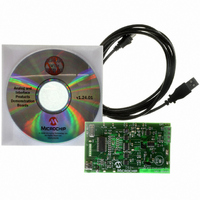TMPSNS-RTD1 Microchip Technology, TMPSNS-RTD1 Datasheet - Page 65

TMPSNS-RTD1
Manufacturer Part Number
TMPSNS-RTD1
Description
BOARD EVAL PT100 RTD TEMP SENSOR
Manufacturer
Microchip Technology
Datasheets
1.MCP3301-CIMS.pdf
(32 pages)
2.PCM18XR1.pdf
(438 pages)
3.MCP6S22DM-PICTL.pdf
(43 pages)
4.TMPSNS-RTD1.pdf
(26 pages)
Specifications of TMPSNS-RTD1
Sensor Type
Temperature
Interface
USB
Embedded
Yes, MCU, 8-Bit
Utilized Ic / Part
MCP3301, MCP6S26, PIC18F2550
Processor To Be Evaluated
MCP6S26, MCP3301, MCP6024, MCP41010, PIC18F2550, TC1071, MCP6002
Data Bus Width
12 bit
Interface Type
USB
Lead Free Status / RoHS Status
Not applicable / Not applicable
Voltage - Supply
-
Sensitivity
-
Sensing Range
-
Lead Free Status / RoHS Status
Lead free / RoHS Compliant, Not applicable / Not applicable
- MCP3301-CIMS PDF datasheet
- PCM18XR1 PDF datasheet #2
- MCP6S22DM-PICTL PDF datasheet #3
- TMPSNS-RTD1 PDF datasheet #4
- Current page: 65 of 438
- Download datasheet (7Mb)
5.2
5.2.1
The microcontroller clock input, whether from an
internal or external source, is internally divided by four
to generate four non-overlapping quadrature clocks
(Q1, Q2, Q3 and Q4). Internally, the program counter is
incremented on every Q1; the instruction is fetched
from the program memory and latched into the Instruc-
tion Register (IR) during Q4. The instruction is decoded
and executed during the following Q1 through Q4. The
clocks and instruction execution flow are shown in
Figure 5-3.
FIGURE 5-3:
EXAMPLE 5-3:
© 2009 Microchip Technology Inc.
Note:
1. MOVLW 55h
2. MOVWF PORTB
3. BRA
4. BSF
5. Instruction @ address SUB_1
OSC2/CLKO
(RC mode)
PIC18 Instruction Cycle
All instructions are single cycle, except for any program branches. These take two cycles since the fetch
instruction is “flushed” from the pipeline while the new instruction is being fetched and then executed.
CLOCKING SCHEME
SUB_1
OSC1
PORTA, BIT3 (Forced NOP)
Q1
Q2
Q3
Q4
PC
Q1
CLOCK/INSTRUCTION CYCLE
INSTRUCTION PIPELINE FLOW
Execute INST (PC – 2)
Fetch INST (PC)
Q2
Fetch 1
PC
T
CY
Q3
0
Q4
Execute 1
Fetch 2
PIC18F2455/2550/4455/4550
T
CY
Q1
1
Fetch INST (PC + 2)
Execute INST (PC)
Q2
Execute 2
Fetch 3
PC + 2
T
CY
Q3
5.2.2
An “Instruction Cycle” consists of four Q cycles: Q1
through Q4. The instruction fetch and execute are pipe-
lined in such a manner that a fetch takes one instruction
cycle, while the decode and execute takes another
instruction cycle. However, due to the pipelining, each
instruction effectively executes in one cycle. If an
instruction causes the program counter to change (e.g.,
GOTO), then two cycles are required to complete the
instruction (Example 5-3).
A fetch cycle begins with the Program Counter (PC)
incrementing in Q1.
In the execution cycle, the fetched instruction is latched
into the Instruction Register (IR) in cycle Q1. This
instruction is then decoded and executed during the
Q2, Q3 and Q4 cycles. Data memory is read during Q2
(operand read) and written during Q4 (destination
write).
2
Q4
Execute 3
Fetch 4
T
CY
INSTRUCTION FLOW/PIPELINING
3
Q1
Execute INST (PC + 2)
Fetch INST (PC + 4)
Fetch SUB_1 Execute SUB_1
Flush (NOP)
Q2
PC + 4
T
CY
Q3
4
Q4
DS39632E-page 63
T
Internal
Phase
Clock
CY
5
Related parts for TMPSNS-RTD1
Image
Part Number
Description
Manufacturer
Datasheet
Request
R

Part Number:
Description:
Manufacturer:
Microchip Technology Inc.
Datasheet:

Part Number:
Description:
Manufacturer:
Microchip Technology Inc.
Datasheet:

Part Number:
Description:
Manufacturer:
Microchip Technology Inc.
Datasheet:

Part Number:
Description:
Manufacturer:
Microchip Technology Inc.
Datasheet:

Part Number:
Description:
Manufacturer:
Microchip Technology Inc.
Datasheet:

Part Number:
Description:
Manufacturer:
Microchip Technology Inc.
Datasheet:

Part Number:
Description:
Manufacturer:
Microchip Technology Inc.
Datasheet:

Part Number:
Description:
Manufacturer:
Microchip Technology Inc.
Datasheet:










